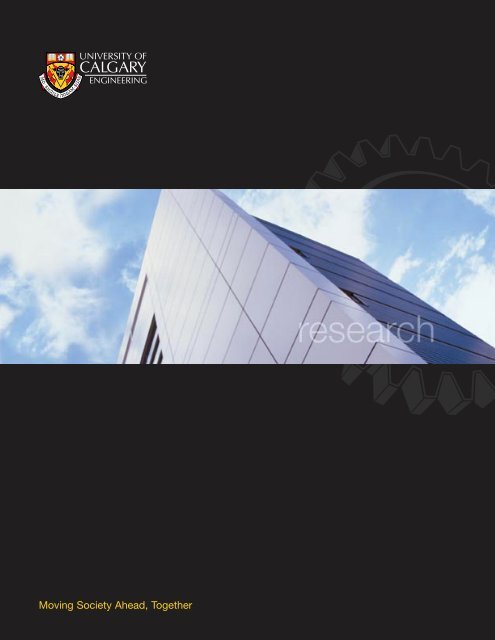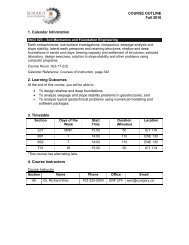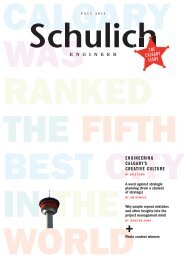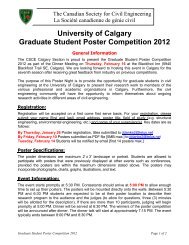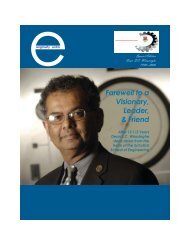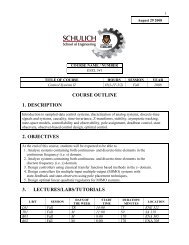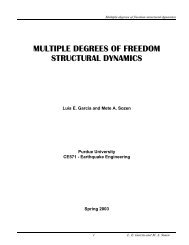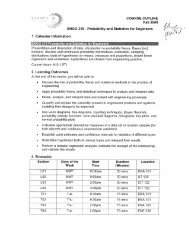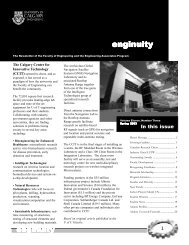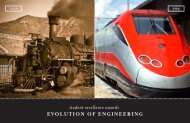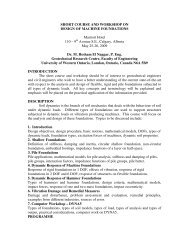Moving Society Ahead, Together - The Schulich School of ...
Moving Society Ahead, Together - The Schulich School of ...
Moving Society Ahead, Together - The Schulich School of ...
You also want an ePaper? Increase the reach of your titles
YUMPU automatically turns print PDFs into web optimized ePapers that Google loves.
<strong>Moving</strong> <strong>Society</strong> <strong>Ahead</strong>, <strong>Together</strong>
Table <strong>of</strong> Contents<br />
01 <strong>Together</strong> We Lead<br />
02 Research Synergies<br />
05 CCIT: Multi-disciplinary Research in Action<br />
06 Bioengineering<br />
10 Information Technologies<br />
14 Infrastructure and Materials<br />
16 Advanced Manufacturing and Design<br />
18 Hydrocarbon and Energy Research<br />
22 Environmental Engineering<br />
24 International and National Collaborations<br />
25 Partners<br />
26 New Collaborators<br />
27 Graduate Studies in Engineering
<strong>Together</strong> We Lead<br />
University <strong>of</strong> Calgary Engineering p1<br />
<strong>Together</strong> We Lead<br />
Message from the Dean<br />
In this brochure we pay tribute to the research programs, pr<strong>of</strong>essors, research fellows, technical<br />
staff, and post-graduate students that have made us an internationally recognized place for outstanding engineering research and technology transfer.<br />
<strong>The</strong> disciplinary strength we have has caused multi-disciplinary research activity to flourish. Basic research and applied industrial research co-exist<br />
side by side. Significant support from NSERC, ASRA, CFI, iCORE, the Alberta Ingenuity Fund, the AHFMR, and major industry partners has also been<br />
instrumental in our success. All major research awards in Canada applicable to engineering research have been won by our academic staff. It has<br />
been a pleasure to support and reward the boom in research that has occurred in our faculty.<br />
Message from the Associate Dean Research <strong>The</strong> Faculty <strong>of</strong> Engineering is a research-intensive faculty with national and international<br />
reputations for the quality and impact <strong>of</strong> its research and graduate programs. This recognition has been achieved because <strong>of</strong> the faculty’s commitment<br />
to excellence, relevance and innovation, close interactions with the industry, timely technology transfer, and quality <strong>of</strong> graduate education. <strong>The</strong> faculty<br />
plans on meeting the challenges <strong>of</strong> the 21st century by expanding its areas <strong>of</strong> strength through industrial partnerships, national and international<br />
collaborations, new research centres and institutes, and the establishment <strong>of</strong> multi-disciplinary programs and facilities for innovative research that<br />
meet the needs <strong>of</strong> society.<br />
Message from the Vice-President (Research) <strong>The</strong> University <strong>of</strong> Calgary is one <strong>of</strong> Canada’s most research-intensive universities. It is a learningcentred<br />
university that promotes a culture <strong>of</strong> inquiry, critical assessment, and problem solving in its students. It is committed to multi- or inter-disciplinary<br />
inquiry recognizing that many <strong>of</strong> the issues facing our society are complex and require collaboration and cooperation among researchers in several<br />
disciplines. <strong>The</strong> Faculty <strong>of</strong> Engineering is a world-class, multi-disciplinary faculty with outstanding research strength in three <strong>of</strong> the university’s four<br />
strategic priority areas: energy and the environment; creating technologies and managing information; and advancing health and wellness.<br />
S. C. Wirasinghe, Ph.D., P.Eng.<br />
Dean, Faculty <strong>of</strong> Engineering<br />
M. G. Sideris, Ph.D., P.Eng.<br />
Associate Dean Research,<br />
Faculty <strong>of</strong> Engineering<br />
D. R. Salahub, Ph.D.<br />
Vice-President (Research),<br />
University <strong>of</strong> Calgary
Research Synergies<br />
University <strong>of</strong> Calgary Engineering p2<br />
Research Synergies<br />
Welcome to the Faculty <strong>of</strong> Engineering, University <strong>of</strong> Calgary, where<br />
outstanding people, divergent perspectives, state-<strong>of</strong>-the-art facilities, focus,<br />
and time create innovation.<br />
Engineering research at the University <strong>of</strong> Calgary uncovers solutions to<br />
issues that impact us now and in the future. Our expert research teams<br />
span the research continuum from discovery at the basic engineering<br />
science level, prototyping and testing, to technology commercialization, and<br />
then back again. Multi-disciplinary, international and industry collaborations<br />
characterize our approach to research and provide the intellectual<br />
infrastructure to solve unique problems. New multi-disciplinary facilities<br />
such as the Calgary Centre for Innovative Technology (CCIT) augment the<br />
physical support to grow our world-class research to a higher level.<br />
Energy & the Environment<br />
As a faculty <strong>of</strong> strength within the University <strong>of</strong> Calgary, the Faculty <strong>of</strong><br />
Engineering is strategically focused on six main areas <strong>of</strong> study:<br />
Bioengineering, Information Technologies, Infrastructure and Materials,<br />
Advanced Manufacturing and Design, Hydrocarbon and Energy Research,<br />
and Environmental Engineering. Each area, rich in expertise, covers a broad<br />
range <strong>of</strong> related research sub-areas.<br />
<strong>The</strong>se areas synergistically support our university’s initiative to become<br />
a world leader in energy and the environment, the advancement <strong>of</strong> health<br />
and wellness, and creating technologies and managing information. As<br />
expertise in one area grows, such as infrastructure, it overlaps and<br />
enhances strength in other areas, such as biomedical research. This<br />
synergy is characteristic <strong>of</strong> engineering research and is key to outcomes<br />
that impact our lives. <strong>The</strong> Venn diagram illustrates this supportive and<br />
interwoven relationship.<br />
Creating Technologies<br />
& Managing Information<br />
Advancing Health & Wellness<br />
Over time, our research enterprise will continue to produce innovation and<br />
directly improve the quality <strong>of</strong> life <strong>of</strong> people in Canada and abroad.
Bioengineering<br />
Bioinstrumentation Sensors and MicroElectroMechanical Systems<br />
(MEMS)<br />
Biomedical Imaging<br />
Cardiovascular Research<br />
Cell and Tissue Engineering<br />
Musculoskeletal Mechanics in Health, Injury and Disease<br />
Pharmaceuticals, Vaccines and Bioreactors<br />
Transplant, Prosthetic, Medical Devices<br />
Information Technologies<br />
Communications Engineering<br />
Digital Imaging<br />
Geospatial Information Systems<br />
Instrumentation and Control Systems<br />
Mechatronics<br />
Project and Information Management<br />
Satellite-Based Positioning, Wireless Location and Navigation<br />
S<strong>of</strong>tware Engineering and Intelligent Agent Systems<br />
VLSI Circuit Design and Electronics<br />
Infrastructure and Materials<br />
Structures and Materials<br />
Smart Structures<br />
Transportation Engineering<br />
Water Management Systems<br />
Advanced Manufacturing and Design<br />
Life-Cycle Design Engineering<br />
Intelligent Manufacturing Systems<br />
Nano/MicroElectroMechanical Systems (Nano/MEMS)<br />
Production Planning, Supply Chain Management and Control<br />
Rapid Manufacturing Processes<br />
Robotics<br />
Hydrocarbon and Energy Research<br />
Alternative Energy<br />
Improved Recovery <strong>of</strong> Oil and Gas<br />
Geomechanics and Reservoir Simulation<br />
Oil and Gas Resources<br />
Oil Sands<br />
Petrochemicals<br />
Reservoir Characterization<br />
Sustainable Hydrocarbon Resource Development<br />
Sequestration <strong>of</strong> Greenhouse Gases (GHG)<br />
Environmental Engineering<br />
Air Quality<br />
Contamination Prevention, Reduction and Recovery<br />
Environmental Design Engineering<br />
Solid Waste Management<br />
Waste-Water Management<br />
Environmental Monitoring and Global Change
Large Photo: Calgary Centre for Innovative Technology (photo courtesy <strong>of</strong> David Brown). Small Photo: RODOPOD.<br />
It’s not just a facility but a philosophy . . .
CCIT: Multi-disciplinary Research in Action<br />
University <strong>of</strong> Calgary Engineering p5<br />
CCIT: Multi-disciplinary Research in Action<br />
<strong>The</strong> Calgary Centre for Innovative Technology, CCIT, is more than a new<br />
research facility. It is a culture and a philosophy for doing multi-disciplinary<br />
research within the Faculty <strong>of</strong> Engineering at the University <strong>of</strong> Calgary.<br />
Researchers from other faculties, universities, institutes, and industries<br />
combine their expertise to develop timely and innovative solutions,<br />
products, and technologies that improve the quality <strong>of</strong> life and global<br />
competitiveness <strong>of</strong> Alberta and Canada.<br />
Four research groups, each with world-renowned teams, occupy the<br />
6,690-square-metre building and challenge the following issues facing<br />
Canada today: health and an aging population, environmental<br />
impact, resource development, deteriorating infrastructure, and next<br />
generation technologies.<br />
<strong>The</strong> Energy High Bay and Hydrocarbon Production Lab provide the<br />
necessary infrastructure for pilot plants, in-situ combustion and highpressure<br />
sour gas, and enhanced recovery research. <strong>The</strong> Structural High<br />
Bay will have the capability to test full-size structural elements used in the<br />
construction and petroleum industries. Biomechanics and biotechnology<br />
research focuses on risk assessment, intervention, prevention and<br />
treatment <strong>of</strong> osteoarthritis. Expertise and facilities for imaging research<br />
include specialized equipment for 3-D visualization, tomography and<br />
bioimaging. <strong>The</strong> ro<strong>of</strong> antenna range enhances the research capacity in<br />
satellite navigation. Wireless and radio frequency research resolves locationrelated<br />
issues. System-on-a-chip opens up entirely new possibilities.<br />
<strong>The</strong> co-location <strong>of</strong> the unique laboratories leads to cross-fertilization <strong>of</strong><br />
ideas and outcomes that impact our global community.<br />
Improving Knee Injury Treatment Our longer, more active<br />
lifestyles are resulting in more sports injuries and a rising percentage <strong>of</strong><br />
Canadians developing osteoarthritis.<br />
While doctors and scientists focus mainly on the biology <strong>of</strong> the joint,<br />
bioengineers excel in discerning the role that cells, tissues, ligaments, and<br />
cartilage play in maintaining the structural integrity <strong>of</strong> a joint.<br />
A common treatment <strong>of</strong> sports injuries involving the anterior cruciate<br />
ligament (ACL) is surgical reconstruction <strong>of</strong> the ligament using other tissue.<br />
Researchers are engineering a RODOPOD System that will accurately<br />
reproduce motion <strong>of</strong> a joint in six degrees <strong>of</strong> freedom during weight-bearing<br />
activities. <strong>The</strong> system will aid in evaluating the changes in joint loading<br />
that result from injury and subsequent surgical intervention.<br />
This research will provide a model to relate the effect <strong>of</strong> joint loads<br />
on the development <strong>of</strong> osteoarthritis and investigate the long-term<br />
implications <strong>of</strong> new surgical procedures. Collaboration with the Faculties<br />
<strong>of</strong> Kinesiology and Medicine will lead to improved treatment methods for<br />
knee injuries, ultimately reducing the effects <strong>of</strong> osteoarthritis following injury.<br />
Inside Reality <strong>The</strong> iCentre is a 3-D visualization cave that <strong>of</strong>fers<br />
researchers the opportunity to be “inside reality.” Three 8' x 8' screens<br />
are set at right angles to each other to create a cave. Using rear projection,<br />
the screens display computer-generated images. A fourth projector reflects<br />
the image from a ceiling-mounted mirror onto the floor. Inside Reality is<br />
the s<strong>of</strong>tware developed by Schlumberger that creates the 3-D images<br />
<strong>of</strong> oil and gas reservoirs. <strong>The</strong> researcher is able to stand within the cave<br />
to observe simulation time steps <strong>of</strong> a reservoir under production or use<br />
a computer mouse to fly through the reservoir seeking geological trends<br />
or optimizing well bore trajectories.<br />
This facility has far-reaching possibilities for many research groups with<br />
the addition <strong>of</strong> other visualization s<strong>of</strong>tware programs. <strong>The</strong> imaging done<br />
with the CT scanners can be viewed in 3-D. <strong>The</strong> Bioengineering group<br />
will be able to create 3-D images <strong>of</strong> joints and related stresses, and rotate<br />
the images to analyze them from various angles. Data from MRIs can be<br />
displayed in 3-D allowing doctors and engineers to proactively develop<br />
surgical procedures and devices. <strong>The</strong> Manufacturing group can also use<br />
CAD drawings to create 3-D images <strong>of</strong> the prototypes. <strong>The</strong> opportunities<br />
for collaborative research are endless.<br />
Seeing is truly believing.
Large Photo: Bioelectrics Lab – Home to micr<strong>of</strong>luidic microchip research.<br />
Bioengineering<br />
Research Areas<br />
Bioinstrumentation Sensors and<br />
MicroElectroMechanical Systems (MEMS)<br />
Biomedical Imaging<br />
Cardiovascular Research<br />
Cell and Tissue Engineering<br />
Musculoskeletal Mechanics in Health, Injury and Disease<br />
Pharmaceuticals, Vaccines and Bioreactors<br />
Transplant, Prosthetic, Medical Devices<br />
Facilities<br />
Human Performance Laboratory<br />
CCIT Bioengineering Suite<br />
McCaig Centre (Foothills Site)<br />
Cardiovascular Laboratories (Foothills Site)<br />
Pharmaceutical Production Research Facility<br />
Bi<strong>of</strong>ilms Research Facility<br />
BioMEMS and Bioelectrics Research Labs<br />
Seamans Medical Imaging Research Centre (Foothills Site)
Bioengineering<br />
University <strong>of</strong> Calgary Engineering p7<br />
Advancing Health and Wellness<br />
With an aging population, and economic and personnel strains on the<br />
health care system, finding financially viable medical solutions is a<br />
priority in Alberta and North America. Advancing Health and Wellness is<br />
a research focus within the University <strong>of</strong> Calgary and the Bioengineering<br />
group <strong>of</strong>fers exceptional expertise, a unique perspective, and dedicated,<br />
award-winning researchers.<br />
<strong>The</strong> Bioengineering group is composed <strong>of</strong> researchers from all engineering<br />
departments, together with colleagues in kinesiology, medicine and<br />
science, as well as those outside the university. <strong>The</strong>se researchers<br />
collaborate on a variety <strong>of</strong> subjects related to human motion and health.<br />
<strong>The</strong> group has expertise in the areas <strong>of</strong> systems physiology, instrumentation,<br />
biotechnology, and biomechanics. Group members seek to improve<br />
diagnosis and treatment <strong>of</strong> injury and diseases. Projects range from<br />
developing techniques to improving diagnostic accuracy from MRIs to<br />
biochemical reactors using genetically modified insect cells to produce<br />
drugs and proteins; from understanding the structural mechanics <strong>of</strong> the<br />
heart to developing non-invasive techniques for assessing scoliosis; from<br />
biomedical sensors at the nanotechnology level (MEMS) to understanding<br />
how loads affect cells in the development <strong>of</strong> osteoarthritis.<br />
<strong>The</strong> potential economic benefit <strong>of</strong> better and/or more economic<br />
treatments that will result from the collaborative efforts <strong>of</strong> this team <strong>of</strong><br />
researchers is incalculable.
Bioengineering<br />
University <strong>of</strong> Calgary Engineering p8<br />
Micr<strong>of</strong>luidic Microchips Detect Life-Threatening Diseases A multidisciplinary<br />
research team is developing a lab-on-a chip – the size <strong>of</strong> your<br />
fingertip – capable <strong>of</strong> detecting life-threatening diseases.<br />
Diseases such as cancer initially affect only a few cells. A lab-on-a-chip<br />
is able to take a small blood sample and examine the DNA properties<br />
<strong>of</strong> each cell. <strong>The</strong> team is using a non-invasive, non-chemical agent<br />
Dielectrophoresis (DEP) levitation method to interrogate cells and<br />
examine their individual electrical properties. This information will aid in<br />
“fingerprinting” diseased cells and facilitate the analysis and recognition<br />
<strong>of</strong> cells for diagnosis.<br />
In addition to expediting the detection <strong>of</strong> diseases, this technology is laying<br />
the foundation for automated medical care. For example, within five years,<br />
implanted smart devices worn by diabetic patients will be able to<br />
automatically administer insulin accurately.<br />
Cardiac Enquiries <strong>The</strong> heart is an incredible pump – it beats<br />
some 2.5 to 3 billion times during the lifetime <strong>of</strong> the average Canadian.<br />
University <strong>of</strong> Calgary researchers are estimating stresses in heart structures<br />
for both normal and abnormal loading, leading to better insight on heart<br />
function and treatment. Analysis <strong>of</strong> the progress <strong>of</strong> a pulse <strong>of</strong> blood down<br />
the aorta is providing new ideas on how the heart and vasculature work<br />
together to provide an energetically efficient system for moving blood<br />
through the body.<br />
Advancements in defibrillators give new hope for people who are treated<br />
for sudden cardiac death. Some 200 to 300 battery-powered defibrillators<br />
are implanted each year in patients in Alberta alone and must be replaced<br />
when the battery is drained. One new approach developed by U <strong>of</strong> C<br />
electrical engineers – the “intelligent defibrillator” – seeks to determine<br />
the exact energy value needed by a patient, decreasing the amount <strong>of</strong><br />
wasted power. <strong>The</strong> device will improve both the reliability and the life <strong>of</strong><br />
the apparatus.<br />
Secret Lives <strong>of</strong> Disc Cells Researchers are investigating the<br />
secret lives <strong>of</strong> one <strong>of</strong> the tiniest components <strong>of</strong> the spine – the disc cell.<br />
<strong>The</strong> disc cell maintains the tissue in the spinal disc. When the spinal disc<br />
undergoes abnormal loading, such as with scoliosis, the cell becomes<br />
nutritionally challenged and subjected to considerable mechanical loads<br />
during everyday activities. Tissue maintenance becomes cumbersome.<br />
In this state, cell density is low and it initially appeared that the cells were<br />
separated by considerable extra-cellular tissue. However, recent studies<br />
suggest that these cells are far more interconnected with long, thin<br />
tentacles that seem to join the cells into a network.<br />
University <strong>of</strong> Calgary researchers are investigating the role <strong>of</strong> these<br />
tentacles. Do they enable intercellular communication and help create a<br />
coordinated response to mechanical stress to maintain the tissue?<br />
Micr<strong>of</strong>luidic microchip Heart research Secret lives <strong>of</strong> disc cells
Bioengineering<br />
University <strong>of</strong> Calgary Engineering p9<br />
Beating Breast Cancer<br />
University <strong>of</strong> Calgary engineering<br />
pr<strong>of</strong>essors are developing novel imaging techniques that will help doctors<br />
in the fight against breast cancer.<br />
A new computer-aided image processing technique enhances<br />
mammogram images. Not only can enhancement lead to early detection<br />
<strong>of</strong> breast cancer, but it helps radiologists make more confident<br />
diagnoses. Additional techniques are being developed to detect several<br />
signs related to breast cancer, and to classify them into various categories.<br />
<strong>The</strong> Applied Electromagnetics group is developing a 3-D imaging technique<br />
that scans the breast with ultra-short electromagnetic pulses. This safe<br />
and comfortable technique may lead to early tumor detection, as well as<br />
allow physicians to distinguish between malignant and benign tumors<br />
without an intrusive biopsy. Furthermore, the cost <strong>of</strong> the process would<br />
be similar to an ultrasound, making it ideal for massive screening purposes.<br />
Implantable Microprocessors Abnormal gastrointestinal content<br />
movement can lead to painful illnesses such as severe constipation,<br />
gastroparesis and potentially even colon cancer. Current treatments involve<br />
invasive surgery and medication.<br />
U <strong>of</strong> C electrical engineers, in collaboration with researchers from Canada,<br />
the U.S., and Europe, are developing implantable microprocessors to assist<br />
with the transportation <strong>of</strong> food through the gastrointestinal system.<br />
<strong>The</strong>ir breakthrough research has created the first successful portable<br />
gastrointestinal stimulator. <strong>The</strong> device, currently used in chronic animal<br />
applications, artificially massages the stomach with electrical stimulation<br />
and induces contractions.<br />
Researchers are now seeking to miniaturize the device for implantation<br />
and are confident that it will soon provide an alternative, less invasive<br />
treatment for these illnesses.<br />
Large-Scale Neural Stem Cell Expansion in Bioreactors Neural<br />
stem cells (NSC) are the “parent” cells <strong>of</strong> all the cells in the central nervous<br />
system (CNS). <strong>The</strong>ir discovery in 1992 opened the door to a multitude<br />
<strong>of</strong> potential therapies and treatments for neurodegenerative diseases such<br />
as Parkinson’s, Multiple Sclerosis, and Huntington’s disease. <strong>The</strong><br />
expected demand for treatment from the millions <strong>of</strong> afflicted individuals,<br />
coupled with the expected demand from biotechnology companies<br />
creating the therapies, has fuelled the development <strong>of</strong> large-scale culture<br />
methods for these cells.<br />
In the Pharmaceutical Production Research Facility (PPRF), researchers<br />
are developing new media and bioreactor protocols for the large-scale<br />
growth <strong>of</strong> mammalian neural stem cells. In collaboration with the Stem<br />
Cell Network, they are also developing protocols to expand large numbers<br />
<strong>of</strong> muscle-derived stem cells (MDSC), hepatic oval stem cells (HOSC),<br />
and pancreatic stem cells.<br />
“Detection <strong>of</strong> breast masses in mammograms<br />
by density slicing and texture<br />
flow-field analysis.” (IEEE Transactions<br />
on Medical Imaging, 20[12]: 1215-1227)<br />
Gastrointestinal research<br />
Pharmaceutical Production<br />
Research Facility
Large Photo: New video techniques advance long track speed skating coaching.<br />
Information Technologies<br />
Research Areas<br />
Communications Engineering<br />
Digital Imaging<br />
Geospatial Information Systems<br />
Instrumentation and Control Systems<br />
Mechatronics<br />
Project and Information Management<br />
Satellite-Based Positioning, Wireless Location<br />
and Navigation<br />
S<strong>of</strong>tware Engineering and Intelligent Agent Systems<br />
VLSI Circuit Design and Electronics<br />
Facilities<br />
Applied Electromagnetics Research Facility<br />
Bioelectric Simulation Laboratory<br />
Image and Multimedia Processing Laboratory<br />
Image and Signal Processing Lab<br />
Laser Scanner for Engineering Metrology<br />
Low-Frequency Instrumentation Laboratory<br />
Microelectronics and VLSI Development and Testing Facility<br />
System-on-a-Chip/Clean Room<br />
Multi-Sensor Laboratory<br />
GPS Signal Simulator<br />
Multiple Reference Station RTK DGPS Network<br />
Water Vapour Radiometer
Information Technologies<br />
University <strong>of</strong> Calgary Engineering p11<br />
Emerging New Technologies<br />
A dramatic acceleration is taking place in the development and use <strong>of</strong><br />
information and communication technologies, with a worldwide transition<br />
to the “Information <strong>Society</strong>.” Many aspects <strong>of</strong> our lives are affected by<br />
this transformation, and new opportunities and challenges are created<br />
with the technological advances. <strong>The</strong> ability to use information effectively<br />
requires solutions from those engaged in the creation <strong>of</strong> new devices and<br />
algorithms for information transmission and analysis, as well as from those<br />
developing new ways <strong>of</strong> handling and using this information.<br />
In the Faculty <strong>of</strong> Engineering, researchers are developing new methods<br />
to advance emerging information technologies, with the potential for<br />
significant industrial and societal impact. Areas <strong>of</strong> research include: mobile<br />
and personal communications, Internet, telematics, microelectronics,<br />
s<strong>of</strong>tware development, simulation and visualization, multi-sensory<br />
interfaces, subsystems and microsystems, and the convergence <strong>of</strong><br />
information and communications technologies. Information technologies<br />
are a strategic academic priority at the University <strong>of</strong> Calgary, where highlevel<br />
research is being conducted with worldwide recognition.
Information Technologies<br />
University <strong>of</strong> Calgary Engineering p12<br />
New Technology . . . New Solutions . . . New Markets . . . <strong>The</strong> design<br />
complexity <strong>of</strong> system-on-a-chip integrated circuits has reached a point<br />
where complete systems can be readily built to address new problems<br />
in a wide variety <strong>of</strong> areas including communications, information<br />
processing, and bio-analysis. A new paradigm <strong>of</strong> circuit design has evolved<br />
where third-party designers can now create part <strong>of</strong> a chip, Intellectual<br />
Property or IP blocks, and sell these blocks to other designers. Designers<br />
need not start from scratch, but can build upon IP blocks to create a<br />
full system.<br />
University <strong>of</strong> Calgary researchers with expertise in bioengineering,<br />
microelectronics, signal processing, and wireless systems are using this<br />
foundation to experiment with novel ideas. <strong>The</strong> time needed for our experts<br />
to produce, test, and demonstrate the industry value <strong>of</strong> our products has<br />
decreased, meaning that industry will gain new technologies that are easy<br />
to integrate, respond to new challenges, and potentially create new markets.<br />
Finding People Everywhere From aircraft navigation and in-car<br />
information systems, to personal digital assistant location and emergency<br />
911 cell-location, the Positioning, Wireless Location and Navigation group<br />
are creating technologies to find people and their locations.<br />
R&D is conducted in partnership with a variety <strong>of</strong> national and foreign<br />
governments and industrial groups. Numerous processes and s<strong>of</strong>tware<br />
have been successfully licensed worldwide.<br />
A Wireless World <strong>The</strong> University <strong>of</strong> Calgary Radio Frequency<br />
Integrated Circuit (RFIC) design group is one <strong>of</strong> the few Canadian university<br />
research groups with expertise in high frequency radio frequency (RF)<br />
wireless analog integrated circuit (IC) design that will help to move the<br />
world towards a truly wireless community.<br />
Short-range wireless communication will soon permeate all aspects <strong>of</strong><br />
our lives, from grocery shopping to vehicle repair.<br />
Using new approaches to develop high-speed wireless local area networks<br />
and high-performance optical fibre communication systems, the group<br />
is building a repertoire <strong>of</strong> IC building blocks needed to realize this world.<br />
Financial support from NSERC, iCORE, and TRLabs, in collaboration with<br />
the TRLabs research consortium, will facilitate technology transfer to<br />
industry and help Canada maintain its position as a leader in advanced<br />
wireless technologies.<br />
Regarded as one <strong>of</strong> the world’s leading academic research groups in this<br />
rapidly growing field, the group conducts research and development related<br />
to the Global Positioning System, the European Galileo System and the<br />
fusion <strong>of</strong> radio frequency and self-contained sensors for applications both<br />
outdoors and indoors.<br />
Information and Communications<br />
Technology building Satellite observation lab TRLabs<br />
Photo courtesy <strong>of</strong> TRLabs.
Information Technologies<br />
University <strong>of</strong> Calgary Engineering p13<br />
New Video Techniques Advance Long Track Speed Skating Coaching<br />
Calgary’s long track speed skating coaches will be using revolutionary<br />
video collection equipment to take their athletes to the gold.<br />
Video analysis is critical to skill improvement in elite athletes. In collaboration<br />
with the Olympic Oval, a team <strong>of</strong> University <strong>of</strong> Calgary electrical engineers<br />
is developing an interconnected system <strong>of</strong> cameras that will automatically<br />
identify and follow an athlete around the track. Additionally, the<br />
technology will store and archive video for enhanced analysis.<br />
<strong>The</strong> technology has the potential to revolutionize sport research. <strong>The</strong> team<br />
expects that the technology will not only save time and money as coaches<br />
are currently required to film performances, but it will also ensure highquality<br />
and consistent data for more accurate analysis.<br />
Saving Lives <strong>The</strong> next time road-side assistance rescues you<br />
from being stranded with a flat tire, think <strong>of</strong> the University <strong>of</strong> Calgary.<br />
Geospatial Information Systems (GIS), positioning and navigation and<br />
wireless technologies comprise the technology needed for location-based<br />
services. <strong>The</strong> integration <strong>of</strong> these technologies has enabled location<br />
identification, wireless communication and information management.<br />
Now Global Positioning System (GPS) receivers that are embedded<br />
in a vehicle or a cell phone can identify emergencies and wirelessly<br />
communicate one’s location to a medical dispatcher. GIS technologies,<br />
refined by U <strong>of</strong> C geomatic engineers, provide medical data services with<br />
the quickest and most efficient route to the emergency.<br />
Anechoic Chamber With one <strong>of</strong> the largest Anechoic Chambers<br />
<strong>of</strong> all Canadian universities, the Applied Electromagnetic Research group<br />
has a site to test their wide range <strong>of</strong> electromagnetic applications.<br />
<strong>The</strong> Anechoic Chamber is completely impenetrable to electromagnetic<br />
radiation (EMR). Hi-tech foam spikes that line the inside <strong>of</strong> the chamber<br />
trap and absorb EMR. With walls that do not reflect radiated energy, the<br />
site will, among other things, be used to develop antennas for new<br />
generations <strong>of</strong> mobile systems.<br />
In one <strong>of</strong> the projects, cellular phone antennas are re-examined. Currently,<br />
the operator’s head absorbs significant amounts <strong>of</strong> electromagnetic waves<br />
radiated by phones. This poses potential health concerns and also results<br />
in system power loss. Researchers will be using the chamber to test<br />
antennas designed to reduce power absorption in the head and to improve<br />
overall system efficiency.<br />
Automated video collection system Realizing location-based services Antenna testing in the Anechoic Chamber
Large Photo: Confederation Bridge. Small Photo: <strong>The</strong> first successful application <strong>of</strong> FRPs in post-tensioned masonry structures.<br />
Infrastructure and Materials<br />
Research Areas<br />
Structures and Materials<br />
Smart Structures<br />
Transportation Engineering<br />
Water Management Systems
Infrastructure and Materials<br />
University <strong>of</strong> Calgary Engineering p15<br />
Building a Better World for our Advancing <strong>Society</strong><br />
From clean drinking water and earthquake-resistant buildings, to 13-km<br />
bridges and efficient and durable roadways, research in the area <strong>of</strong><br />
infrastructure and materials has a direct impact on our daily lives.<br />
Historically, research was aimed at the design, construction, and operation<br />
<strong>of</strong> infrastructure. However, in today’s economic environment, which<br />
emphasizes life-cycle costs, there is an increasing emphasis on<br />
management and monitoring <strong>of</strong> infrastructure.<br />
Research at the University <strong>of</strong> Calgary is focused on improving the economics,<br />
reliability and sustainability <strong>of</strong> these necessary, but expensive, elements<br />
<strong>of</strong> modern society.<br />
University <strong>of</strong> Calgary’s Materials group is developing and testing new,<br />
high-performance, traditional and advanced composite materials. <strong>The</strong>se<br />
materials will result in more durable and reliable infrastructure that will last<br />
longer and result in reduced life-cycle cost.<br />
Planning models developed by our Transportation group are being used<br />
by cities within Europe and North America to determine transportation<br />
needs and trends in cities, impacts <strong>of</strong> societal choices, and pressures<br />
on the flow <strong>of</strong> traffic.<br />
As our global population grows, water quality and security <strong>of</strong> water supply<br />
is critical. Research on the treatment and management <strong>of</strong> water supply<br />
will lead to very significant improvements in water quality and reduction<br />
in per capita water consumption.<br />
Sensors, and sensor systems, are being used by our Structures group<br />
to understand how structures perform under actual conditions. This<br />
information will refine the design <strong>of</strong> infrastructure elements leading to<br />
reduced initial cost, and better long-term management <strong>of</strong> our infrastructure.<br />
Researchers from all departments within the faculty, particularly Civil<br />
Engineering, collaborate with faculty members from the Sciences and<br />
Social Sciences on these and other projects. <strong>Together</strong>, these researchers<br />
are building better infrastructure for our advancing society.<br />
Ice Research – Uniting People, Improving Economies University<br />
<strong>of</strong> Calgary civil engineers are leading authorities on ice research and were<br />
key to the development and design <strong>of</strong> the Confederation Bridge – a bridge<br />
required to withstand significant ice forces. <strong>The</strong> 13-km bridge, which<br />
connects Prince Edward Islanders to the mainland, facilitates not only<br />
increased employment opportunities and tourism, but also potential<br />
benefits for future <strong>of</strong>fshore construction and oil and gas industries.<br />
Researchers currently monitor, in real time without ever leaving Calgary,<br />
the impact <strong>of</strong> ice on the Confederation Bridge. Data collected from new<br />
and reliable ice force instrumentation will facilitate the creation <strong>of</strong> numerical<br />
models to predict ice forces on structures. <strong>The</strong> results <strong>of</strong> their research<br />
will enable engineers to cost-effectively design structures resistant to<br />
external forces.<br />
Assessing Potential Futures <strong>The</strong> use <strong>of</strong> the high-speed rail link<br />
from London to the Channel Tunnel, and on to Paris and Brussels, was<br />
determined for British Rail. Potential strategies for diverting traffic and<br />
encouraging more dispersed economic growth were tested for the Oregon<br />
Department <strong>of</strong> Transportation. How? Using mathematical models<br />
developed by University <strong>of</strong> Calgary’s world-class transportation engineers.<br />
<strong>The</strong>se mathematical models <strong>of</strong> spatial economic systems place<br />
transportation systems within the larger economic system. <strong>The</strong>y integrate<br />
psychological, economic, and geographical data, including descriptions<br />
<strong>of</strong> household and business decisions about where to locate and how to<br />
travel and transport goods and services. Alternative scenarios are then<br />
considered in order to assess the expected costs and benefits <strong>of</strong> new<br />
systems <strong>of</strong> infrastructure, pricing, and regulation. Governments around<br />
the world are making wiser decisions thanks to the University <strong>of</strong> Calgary.<br />
Building on Strength Structural engineering research has been<br />
a longstanding area <strong>of</strong> strength for the University <strong>of</strong> Calgary. Researchers<br />
have patented numerous building-life extending and strengthening<br />
reinforcement technologies, such as shear studs. A new generation <strong>of</strong><br />
researchers is continuing this tradition.<br />
One such researcher recently implemented the first successful application<br />
<strong>of</strong> Carbon Fibre Reinforced Polymers (FRPs) used in post-tensioned<br />
masonry structures. FRPs <strong>of</strong>fer an exciting alternative to steel. Not only<br />
is it lighter and stronger than steel, but the plastic material is not susceptible<br />
to corrosion, extending the sustainable life span <strong>of</strong> a structure and reducing<br />
the need for maintenance. <strong>The</strong> performance <strong>of</strong> FRPs and a University <strong>of</strong><br />
Calgary patented anchorage system is being monitored at CCIT.
Large Photo: Robotics and Automation Lab. Small Photos – Top: Students at the Canadian Engineering Memorial Foundation<br />
Dean’s Millennium Award-winning table. Bottom: Teaching the fundamentals <strong>of</strong> hyper-redundancy in nanorobotics.<br />
Advanced Manufacturing and Design<br />
Research Areas<br />
Life-Cycle Design Engineering<br />
Intelligent Manufacturing Systems<br />
Nano/MicroElectroMechanical Systems (Nano/MEMS)<br />
Production Planning, Supply Chain Management and Control<br />
Rapid Manufacturing Processes<br />
Robotics<br />
Facilities<br />
Rapid Prototyping Machine<br />
Five-axis Milling Machine<br />
Mechatronics Design Lab<br />
CAD/CAM/CAE Systems<br />
Coordinate Measuring Machines<br />
Programmable Logic Controllers<br />
Robotic Workcell
Advanced Manufacturing and Design<br />
University <strong>of</strong> Calgary Engineering p17<br />
Paradigm Shift<br />
Henry Ford revolutionized the automotive industry not with the Model T<br />
but by changing the way we thought about and constructed automobiles.<br />
He implemented the first successful large-scale manufacturing innovation<br />
– the assembly line.<br />
Engineering researchers at the University <strong>of</strong> Calgary are not only developing<br />
technologies and methodologies that will further advance manufacturing<br />
innovations but will also change the way we think <strong>of</strong> design.<br />
Manufacturing involves the creation <strong>of</strong> products. A well-designed<br />
manufacturing enterprise will conduct this work in a resource-efficient<br />
manner to produce high-quality results that meet the needs <strong>of</strong><br />
consumers. This demands flexibility, reconfigurability and the creation <strong>of</strong><br />
new technological advancements.<br />
<strong>The</strong> Manufacturing Engineering group is using advanced manufacturing<br />
concepts such as intelligent agent-based systems and the latest in design<br />
engineering paradigms to develop the next generation <strong>of</strong> integrated<br />
manufacturing systems. From understanding the management and<br />
trade<strong>of</strong>fs <strong>of</strong> production planning and control, and selecting appropriate<br />
information systems, to examining the flow <strong>of</strong> information and materials<br />
from suppliers to the end user, researchers are revealing information that<br />
will enhance industry competitiveness in a global market.<br />
Design research is aimed at furthering the development <strong>of</strong> competitive<br />
products and systems. Researchers are expanding design theories and<br />
methodologies in life-cycle, modular, and intelligent design, as well as in<br />
design for manufacturing and the development <strong>of</strong> design information<br />
systems. <strong>The</strong> result <strong>of</strong> this research will change the way we think in<br />
designing a product, not to mention the design process, bringing both<br />
environmental, as well as economic, considerations to the forefront <strong>of</strong> the<br />
design process.<br />
A dynamic and vibrant collection <strong>of</strong> eminently qualified scientists, these<br />
researchers are leading a paradigm shift that will result in innovative<br />
solutions to meet industry needs.<br />
Environmentally Friendly Products – It’s all in the Design Once<br />
upon a time, when a design engineer sat down to create a product, her<br />
first consideration was the “useful” life span <strong>of</strong> the product. Now University<br />
<strong>of</strong> Calgary engineers are redefining these considerations to span the life<br />
cycle <strong>of</strong> a product from the materials and energy used to develop the<br />
product to the disposal <strong>of</strong> the product.<br />
University <strong>of</strong> Calgary engineers are developing new design methods, such<br />
as adaptable design and bus systems, to help engineers make superior<br />
design choices in the less expensive developmental stage <strong>of</strong> a product.<br />
Results will lead to environmentally responsible and economically viable<br />
choices, such as materials that will not only enhance the durability <strong>of</strong> a<br />
product, but also decompose in an efficient and friendly fashion.<br />
Intelligent Manufacturing From integrating complex systems<br />
to fault diagnosis, University <strong>of</strong> Calgary research is making manufacturing<br />
intelligent and automatic.<br />
Advances in factory automation increased manufacturers’ reliance on<br />
computer-based control systems. <strong>The</strong> complexity <strong>of</strong> these systems,<br />
however, was typically beyond the capabilities <strong>of</strong> conventional centralized<br />
computer control approaches. University <strong>of</strong> Calgary’s Agent-Based<br />
Systems, which take advantage <strong>of</strong> distributed hardware and s<strong>of</strong>tware<br />
technology, gave manufacturers a practical solution to an expensive<br />
problem. <strong>The</strong> result was real-time intelligent computer automation.<br />
Other projects will soon make their way to the manufacturing floor.<br />
Intelligent robots able to learn, do, and improve on the competence and<br />
speed <strong>of</strong> a repetitive action are being created that will result in considerable<br />
time and cost savings to industry. Artificial intelligence using sound patterns<br />
will identify pre-failure bearings enabling companies to conduct repairs<br />
without halting production.<br />
Small Gadgets, Big Results A MicroElectroMechanical System<br />
(MEMS) the size <strong>of</strong> a postage stamp, containing millions <strong>of</strong> microscopic<br />
mirrors each tilting 5,000 times a second, is changing your den into a<br />
media multiplex.<br />
MEMS possess the power to become the hallmark <strong>of</strong> the 21st century<br />
in manufacturing technology. <strong>The</strong>y integrate mechanical elements, sensors,<br />
actuators, and electronics on a common silicon substrate using<br />
micr<strong>of</strong>abrication technology.<br />
<strong>The</strong> MEMS technology being forged at the University <strong>of</strong> Calgary has far<br />
reaching applications that extend well beyond your den, to your cell phone,<br />
your automobile navigation system, and even to your body. Researchers<br />
in Manufacturing Engineering are creating foundational technology, such<br />
as noninvasive precision metrology for MEMS development. Electrical<br />
engineers are building on the technology to create systems-on-a-chip,<br />
while Geomatic engineers are integrating GPS receivers with MEMS to<br />
improve vehicular navigation.
Hydrocarbon and Energy Research<br />
Research Areas<br />
Alternative Energy<br />
Improved Recovery <strong>of</strong> Oil and Gas<br />
Geomechanics and Reservoir Simulation<br />
Oil and Gas Resources<br />
Oil Sands<br />
Petrochemicals<br />
Reservoir Characterization<br />
Sustainable Hydrocarbon Resource Development<br />
Sequestration <strong>of</strong> Greenhouse Gases (GHG)<br />
Facilities<br />
Air Injection Research Laboratory<br />
Primary Production, SAGD, Solvent Extraction Laboratories<br />
Geomechanics and Reservoir Simulation and<br />
Modelling Laboratories<br />
Virtual Reality and Imaging Laboratories –<br />
CT, MRI, 3-D Visualization<br />
Reservoir Fluids Behaviour and Characterization Laboratory<br />
Gas Hydrate Laboratory<br />
Underbalanced Drilling and Industrial Safety Laboratories
Hydrocarbon and Energy Research<br />
University <strong>of</strong> Calgary Engineering p19<br />
World Leaders in Energy Research<br />
Canada is a world leader in the hydrocarbon and energy industry, with<br />
state-<strong>of</strong>-the-art technologies associated with economic and environmentally<br />
sustainable production <strong>of</strong> oil and gas. Engineering researchers from the<br />
University <strong>of</strong> Calgary have been and continue to be instrumental in<br />
establishing and perpetuating this leadership position.<br />
Located in Canada’s oil and gas capital, University <strong>of</strong> Calgary researchers<br />
have developed and refined key processes, such as steam-assisted gravity<br />
drainage (SAGD), Vapor Solvent Extraction (VAPEX), Air Injection and<br />
Cold Production, that contribute to the sustainable development <strong>of</strong><br />
hydrocarbon resources in Alberta and worldwide. Current research is aimed<br />
at developing novel technologies to enhance ultimate recovery <strong>of</strong><br />
hydrocarbon resources while significantly reducing environmental footprints.<br />
Oil and gas, chemical, electrical, civil, and mechanical engineers contribute<br />
to our international recognition in applied reservoir modelling, development<br />
<strong>of</strong> innovative technologies for recovery <strong>of</strong> conventional and heavy oils,<br />
computational thermodynamics, and kinetics <strong>of</strong> hydrate formation and<br />
decomposition.<br />
Research groups include: Cold Production (VAPEX), Foamy Oil, Polymers,<br />
Steam Injection, Air Injection, Geotechnical and Reservoir Simulation,<br />
Process Simulation, Gas Hydrates, In-Situ Upgrading, Visualization and<br />
Imaging, Sustainable Hydrocarbon Resource Development (Sequestration<br />
<strong>of</strong> Greenhouse Gases), and Fuel Cells.<br />
Research programs integrate the collective expertise <strong>of</strong> the researchers and<br />
utilize state-<strong>of</strong>-the-art research facilities for developing solutions to practical<br />
problems encountered in the recovery <strong>of</strong> hydrocarbons from reservoirs.<br />
Photo courtesy <strong>of</strong> Nexen Inc.
Hydrocarbon and Energy Research<br />
University <strong>of</strong> Calgary Engineering p20<br />
Light Your Fire<br />
Oil and gas engineers are developing<br />
environmentally sensitive recovery methods that require less water than<br />
conventional techniques and will access volumes <strong>of</strong> untapped conventional<br />
and heavy oil.<br />
Conventional techniques can use up to six barrels <strong>of</strong> water to produce<br />
one barrel <strong>of</strong> oil and they emit carbon dioxide and oxides <strong>of</strong> sulphur and<br />
nitrogen directly into the air. Oil and gas engineers are refining an air injection<br />
process, used for both heavy and light oil, that is easily accessible both<br />
on and <strong>of</strong>fshore, does not require water, and which reduces the volumes<br />
<strong>of</strong> carbon dioxide per volume <strong>of</strong> oil produced. Researchers hope the<br />
process will double the output <strong>of</strong> oil recovery and anticipate a five percent<br />
increase in light oil recovery.<br />
A hybrid process is currently being used to extract the volumes <strong>of</strong> untapped<br />
heavy oil embedded deep within the thousands <strong>of</strong> primary wells that<br />
currently lace Alberta’s prairies.<br />
Geomechanical Behaviours <strong>of</strong> Reservoirs Stresses, deformation<br />
and fracturing have large implications in many areas <strong>of</strong> oilfield<br />
development. This is particularly serious during seismic exploration,<br />
reservoir forecasting, drilling, sand production and other exploration<br />
activities. Only recently have researchers come to understand the impact<br />
<strong>of</strong> this geomechanical behaviour.<br />
Researchers believe their discoveries will have tremendous implications<br />
on the petroleum industry. One example is a new modelling technique<br />
that accounts for formation damage and stress changes in very high rate<br />
injection wells for the disposal <strong>of</strong> produced water. This system will be critical<br />
to the Yemen operations <strong>of</strong> Nexen Inc., where more than half a million<br />
barrels <strong>of</strong> water must be disposed <strong>of</strong> daily.<br />
Looking Beneath the Earth <strong>The</strong> University <strong>of</strong> Calgary has the<br />
largest integrated process tomography facility in Canada.<br />
Some 30 multi-disciplinary researchers in the Porous Media and Process<br />
Tomography Research group are using non-invasive imaging tools and<br />
computer models to understand physical and chemical problems<br />
associated with the recovery and processing <strong>of</strong> hydrocarbon resources.<br />
Operating one <strong>of</strong> the largest tomographic analysis laboratories in North<br />
America, researchers are determining how certain fluids flow and are<br />
distributed in porous materials (e.g. rock and soils) and how they interact<br />
with other fluids or solids. Models, such as the NMR-based water-cut<br />
meter, are developed, commercialized and then used by industry to<br />
cultivate optimal processes to increase production, reduce operational<br />
costs in hydrocarbon processing, and lower air and water pollutants.<br />
Air injection research<br />
Yemen operations <strong>of</strong> Nexen Inc.<br />
MRIs provide a new perspective in<br />
hydrocarbon research<br />
Photo courtesy <strong>of</strong> Nexen Inc.
Hydrocarbon and Energy Research<br />
University <strong>of</strong> Calgary Engineering p21<br />
Ice Energy Trapped in ice-like formations, embedded within the<br />
soil and rocks <strong>of</strong> permafrost and <strong>of</strong>fshore regions, lay vast untapped<br />
sources <strong>of</strong> natural gas known as gas hydrates. A team <strong>of</strong> researchers,<br />
complemented by a new state-<strong>of</strong>-the-art geotechnical testing laboratory,<br />
are conducting research that will lead to enhanced energy recovery.<br />
Researchers are exploring the physical effects <strong>of</strong> gas hydrate formation<br />
and decomposition on the surrounding sediments, to better understand<br />
the geomechanical behaviour <strong>of</strong> gas hydrate-sediment mixtures. <strong>The</strong> results<br />
<strong>of</strong> this research will contribute not only to developing the technologies<br />
required for characterization <strong>of</strong> hydrate reserves and formulation <strong>of</strong> field<br />
recovery strategies, but also to improving the understanding <strong>of</strong> gas<br />
hydrates as an <strong>of</strong>fshore geohazard and determining their role in submarine<br />
slope stability.<br />
Solutions to Energy Problems Heavy oil and bitumen account<br />
for more than half <strong>of</strong> the total oil production in Alberta. University <strong>of</strong> Calgary<br />
researchers are investigating new methods to improve the efficiency <strong>of</strong><br />
its production.<br />
A promising new process for bitumen and heavy oil recovery – Vapex –<br />
was created at the University <strong>of</strong> Calgary and is currently being refined.<br />
Researchers are also evaluating different hydrocarbon additives to reduce<br />
the steam requirements for steam assisted gravity drainage (SAGD) and<br />
to extend the applicability <strong>of</strong> the process to marginal reservoirs. Finally,<br />
foamy oil – a two-phase flow in which the gas remains dispersed in the<br />
oil – dramatically enhances performance compared to the results predicted<br />
by the conventional theory. Researchers are systematically examining this<br />
type <strong>of</strong> flow to determine what causes it and how it can be exploited to<br />
improve production <strong>of</strong> heavy oil.<br />
Eco-Efficiency U <strong>of</strong> C engineers are creating eco-efficient<br />
models and techniques for chemical and petroleum process plants that<br />
are good for the environment – and business.<br />
Researchers consider both ecological and economic factors when<br />
developing successful eco-efficient processes. With better control <strong>of</strong><br />
chemical and petroleum process plants, energy use is minimized while<br />
production rates are maximized. Less energy output means reduced<br />
greenhouse gas emissions, water usage and operating costs.<br />
One such process is in the midst <strong>of</strong> being patented – a new measurement<br />
technique for acid-gas-loading amine plants. An amine plant, found in<br />
many sour gas processing plants, absorbs greenhouse gases. This new<br />
sensor will measure the concentration <strong>of</strong> acid gas the amine unit is<br />
absorbing, insuring that it is functioning optimally. <strong>The</strong> result is reduced<br />
operating cost for business and a healthier environment for us all.<br />
Geotechnical testing laboratory<br />
U <strong>of</strong> C researchers are providing<br />
solutions to energy problems<br />
Eco-efficient models and techniques for<br />
chemical and petroleum process plants
Large Photo: High-tech water management. Small Photos – Left: U <strong>of</strong> C to aid Chilean waste management issue. Right: Methano Bi<strong>of</strong>ilter solves macro problem.<br />
Environmental Engineering<br />
Research Areas<br />
Air Quality<br />
Contaminant Prevention, Reduction and Recovery<br />
Environmental Design Engineering<br />
Solid Waste Management<br />
Waste-Water Management<br />
Environmental Monitoring and Global Change
Environmental Engineering<br />
University <strong>of</strong> Calgary Engineering p23<br />
Considering the Future Impacts <strong>of</strong> Today’s Choices<br />
Back in the 50s, “Advancing <strong>Society</strong>” into the 21st century meant<br />
accumulation, consumerism, and ease <strong>of</strong> life. Today, “Advancing<br />
<strong>Society</strong>” beyond the 21st century depends on our ability to globally sustain<br />
our basic resources – soil, air and water – and to make choices for<br />
technological development responsibly. Considering the future impacts<br />
<strong>of</strong> today’s choices, as well as developing remedial solutions to the choices<br />
<strong>of</strong> yesteryear, is the task <strong>of</strong> the University <strong>of</strong> Calgary’s environmental<br />
engineers.<br />
Working in the Centre for Environmental Engineering Research and<br />
Education (CEERE), our team <strong>of</strong> cross-disciplinary engineers collaborate<br />
with learners, educators and industry pr<strong>of</strong>essionals to resolve complex<br />
issues from a multi-disciplinary perspective. Graduate students entering<br />
the environmental engineering program are trained in this multidisciplinary<br />
style and benefit from the supervision <strong>of</strong> over 25 pr<strong>of</strong>essors<br />
from various disciplinary backgrounds.<br />
<strong>The</strong> environmental engineering group is engaged in a wide variety <strong>of</strong> basic<br />
and applied research projects in greenhouse gas emission control,<br />
remediation/toxicity <strong>of</strong> contaminated sites, contaminant/gas migration in<br />
soils, industrial emission treatment/control, optimization <strong>of</strong> full-scale<br />
fermentors, surface/ground water quality, conjunctive use <strong>of</strong> surface water<br />
reservoirs, sulphur emissions from Claus plants, acoustical emissions in<br />
combustion systems, and environmental monitoring with remote sensing.<br />
Additionally, researchers collaborate internationally on research and<br />
educational projects in many South American and Asian countries.<br />
<strong>Together</strong>, our team <strong>of</strong> researchers, learners, and industry pr<strong>of</strong>essionals<br />
creates technologies and processes that enable society to coexist in<br />
harmony with nature while continuing to maintain our modern-day quality<br />
<strong>of</strong> life in a sustainable manner.<br />
New Landfills Re-use, Recycle and Reduce in New Ways New<br />
sustainable landfill technology promises to re-use landfill space, recycle<br />
untapped energy found in waste, and reduce landfill methane gas emission<br />
to zero.<br />
For sustainable landfills, waste is a resource. Waste produces high quantities<br />
<strong>of</strong> methane gas, a greenhouse gas with a global warming potential <strong>of</strong> 23<br />
over a 100-year time horizon. In a sustainable landfill, methane gas is<br />
extracted and used to generate energy. A soil bi<strong>of</strong>ilter caps the landfill<br />
and traps the remaining methane gas. <strong>The</strong> gas is then transformed into<br />
less harmful carbon dioxide by millions <strong>of</strong> microorganisms living in the<br />
bi<strong>of</strong>ilter. <strong>The</strong> result is complete elimination <strong>of</strong> landfill methane emissions,<br />
reducing global anthropogenic methane emissions by about 15 percent!<br />
U <strong>of</strong> C researchers are currently testing and refining techniques for largescale<br />
implementation. <strong>The</strong> technology will be transferred to third-world<br />
countries with significant waste management issues.<br />
Micro-organisms Solve Macro Problem Most <strong>of</strong> the solution<br />
gas from oil production is recovered for beneficial uses. However, some<br />
<strong>of</strong> this gas, high in methane, is disposed <strong>of</strong> through flaring, or direct venting<br />
into the atmosphere. Venting contributes to Alberta’s already elevated<br />
greenhouse gas emission numbers and flaring produces toxic by-products.<br />
University <strong>of</strong> Calgary’s Methano Bi<strong>of</strong>ilter technology promises to solve part<br />
<strong>of</strong> the problem. Methano Bi<strong>of</strong>ilters use micro-organisms to convert methane<br />
gas into less harmful carbon dioxide. <strong>The</strong> gas is then emitted into the<br />
atmosphere. <strong>The</strong> technology is most effective with small quantities <strong>of</strong><br />
solution gas.<br />
<strong>The</strong> multi-disciplinary creators <strong>of</strong> the Bi<strong>of</strong>ilter are refining the technology<br />
and working with TransCanada PipeLines and Husky Energy to<br />
demonstrate the value <strong>of</strong> this research through two field projects.<br />
High-Tech Water Management Forest fires, urbanization and<br />
floods can have sizable impacts on one <strong>of</strong> our most valued resources –<br />
water. High-tech water management tools, developed and used at the<br />
University <strong>of</strong> Calgary, are providing new options for wiser water<br />
management decisions.<br />
Geographic Information Systems (GIS) have the capacity to manipulate<br />
and integrate specific spatial information such as elevation, soil type and<br />
landcover. Results from this relatively under-exploited tool are assisting<br />
researchers in predicting the impacts <strong>of</strong> forest fires and climate change<br />
on the boreal forest, as well as determining the impacts <strong>of</strong> urbanization<br />
on run<strong>of</strong>f.<br />
Civil engineers are collaborating with the City <strong>of</strong> Calgary to produce a water<br />
distribution model that will provide real-time accurate data on water quality<br />
and quantity. This kind <strong>of</strong> information will enhance operational decisions<br />
and help avoid disasters such as contamination.
International and National Collaborations<br />
University <strong>of</strong> Calgary Engineering p24<br />
<strong>The</strong>re’s No “i” in Team<br />
International and National Collaborations <strong>The</strong> Faculty <strong>of</strong> Engineering at the University <strong>of</strong> Calgary has fostered partnerships spanning the<br />
globe, from the deserts <strong>of</strong> Abu Dhabi to the mountain villages <strong>of</strong> Nepal. Through such collaborations, faculty members gain the multi-disciplinary<br />
perspective and the industry support to find solutions to the issues facing all researchers. <strong>The</strong>se relationships are key to research and education at<br />
the U <strong>of</strong> C.<br />
Faculty members collaborate with academic and industry colleagues both nationally and internationally in various research projects. Many <strong>of</strong> these<br />
initiatives are under the umbrellas <strong>of</strong> Networks <strong>of</strong> Centres <strong>of</strong> Excellence (NCEs) and are detailed in the preceding stories. Student and faculty exchange<br />
programs have been established with many universities. Other examples <strong>of</strong> successful alliances include international course instruction, and development<br />
and service work with many scientific and pr<strong>of</strong>essional organizations.<br />
Collaborative and inter-disciplinary research and education is encouraged and supported through faculty initiatives. <strong>The</strong> new CCIT Building, for example,<br />
provides shared laboratory space where multi-disciplinary research is taken to new levels and is attracting top academics and graduate students to<br />
work and study at the University <strong>of</strong> Calgary. Multi-disciplinary programs, such as the Environmental Engineering program, also combine disciplinary<br />
expertise from across both the faculty and the University to provide the training essential for high-quality personnel that will make a difference. Collaborations<br />
with diverse faculties, other institutions and industry are leading to significant breakthroughs and improved multi-disciplinary programs.<br />
<strong>Together</strong> we are impacting the world.<br />
Lighting up the World U <strong>of</strong> C electrical engineers are lighting<br />
up villages throughout Nepal, Niger, Tanzania, Suriname, Bolivia and<br />
Argentina with White Light Emitting Diodes (WLEDs). Powered by Pedal<br />
Generators, Pico Hydro and Solar photovoltaic, WLEDs provide safe,<br />
healthy, rugged, long-lived, green, energy-frugal and affordable light. <strong>The</strong><br />
system can light up a home with just one watt!<br />
Oil and Gas Connections University <strong>of</strong> Calgary oil and gas<br />
experts are assisting Abu Dhabi Petroleum University (ADPU) with the<br />
establishment <strong>of</strong> their new petroleum university. <strong>The</strong> ADPU Director credits<br />
the U <strong>of</strong> C with having an excellent range <strong>of</strong> programs that can be easily<br />
adopted by their institution. Through partnerships, the universities will<br />
develop educational programs and research projects, and collaborate in<br />
the training <strong>of</strong> researchers and pr<strong>of</strong>essors.<br />
Thulo Pokhara, Nepal – the first village to be lit with WLEDs<br />
International<br />
Activities and<br />
Collaborations
Partners<br />
University <strong>of</strong> Calgary Engineering p25<br />
Partners<br />
We would like to acknowledge the institutions and individuals with whom we partner.<br />
Adjeleian Allen Rubeli Limited, Ain Shams University, Ajou University, Al.I.Cuza University, Albemarle Corp., Alberta Energy Company Ltd., Alberta<br />
Transportation, Amoco Canada Petroleum Company, Amoco Production Company – USA, ApTech, Applied Pavement Technologies, Asian Institute<br />
<strong>of</strong> Technology, Australian Road Research Board, AUTO 21 NCE, Ben Gurion University <strong>of</strong> the Negev, Boston University, BP, BP Amoco, BP Canada<br />
Resources, Burlington Resources, Cambridge University, Canadian Association <strong>of</strong> Petroleum Producers (CAPP), Canadian Coast Guard, Canadian<br />
Geomatic Solutions Ltd., Canadian Nuclear Safety Commission, Canadian Space Agency, CANMET, C-CORE, Cergy-Pontoise University, China National<br />
Petroleum Corporation, Chosun University, Chris Stethem and Associates, CIDA, City <strong>of</strong> Calgary, City <strong>of</strong> Fredericton, Cleveland Clinic Foundation,<br />
Communications Research Centre Canada, Concordia University, Construction Research Institute <strong>of</strong> Canada, Continental Oil, Costas Armenakis, Czech<br />
Academy <strong>of</strong> Sciences, DALSA Inc., Danish National Survey and Cadastre, David Simmonds Consultancy, Delft University <strong>of</strong> Technology, Department<br />
<strong>of</strong> Fisheries and Oceans – Manitoba, Department <strong>of</strong> National Defence – Canada, Dominion Radio Astronomy Observatory, École des Mines de Paris,<br />
École Nationale d’Ingénieurs de Tunis, EnCana Corporation, ENS de Cachan, Ericsson USA, ETH Zurich, European Space Agency, Federal Highway<br />
Administration, FINA Resources Inc., FONDEF, Gennum Corp., GeoAnalytic, Geomatics Canada, Georgia Institute <strong>of</strong> Technology, GEOsurv Inc.,<br />
Geotechnical Consulting: Reza Imam, GFZ Potsdam, Golder Associates, Gotenburg University, Graz University <strong>of</strong> Technology, Helsinki University <strong>of</strong><br />
Technology, Henry G. Russell, Inc., Heriot-Watt University, Hitachi/DX Antenna, Hong Kong Polytechnic, Hunt Oil, Husky Energy, HydroQual Laboratories,<br />
IIT, Imperial College, Imperial College <strong>of</strong> Science, Technology & Medicine, Imperial Oil Limited, Imstrat Corporation, Institute for Mathematics & Fundamental<br />
Physics, Israel Institute <strong>of</strong> Technology, Konkuk University, Japan National Oil Corporation, Korea Astronomical Observatory, KULeuven, Laval University,<br />
Manitoba Hydro, Massachusetts Institute <strong>of</strong> Technology: M. Ben-Akiva, McGill University, McMaster University, MediVators. Inc, Memorial University,<br />
Mobil USA, Mobil Oil Company, Modelistica, MOL Rt. (Hungarian Oil and Gas Co.), Monash Institute <strong>of</strong> Reproduction & Development, Montreal Heart<br />
Institute, Morse Bros., Moscow State Technical University, National Center for Upgrading Technology, National Iranian Oil Corporation, National Research<br />
Council <strong>of</strong> Canada, National University <strong>of</strong> Singapore, Natural Resources Canada, New Jersey Institute <strong>of</strong> Technology, New York University, Nexen<br />
Inc., NIOSH, Nokia Mobile Telephone Co., Northwestern University, Norwegian Geotechnical Institute, Nova Chemicals Ltd., NovAtel Inc., NRCan,<br />
NSERC, Oakland University, Occidental <strong>of</strong> Elk Hills (US Oxy), Ohio State University, Oil and Natural Gas Corporation Limited, Okajama University, Old<br />
Medical <strong>School</strong>, Optech Inc., Oriental Construction Co, Petro-Canada, Petroleum Technology Alliance Canada, Petroleum University <strong>of</strong> Technology,<br />
Petroperu, Portland State University, Queen’s University, Ralph Whitehead Associates Inc, Raytheon GmbH, Repsol YPF, Res. Inst. for Pet. & Hydrocarbon<br />
Gases, Roberton Enterprises Ltd., Rolls-Royce GTE (Canada) Inc., Rush Medical Centre, RWTH Aachen, Ryerson University, St. George’s Hospital,<br />
Scottish Water Authority, Shell Canada Limited, Shell Wester E & P USA, SiRF, Slovak Technical University, Soonchunhyang University, Southern Methodist<br />
University, Space Research Organization Netherlands, Spatial-link, Stanford University, Swedish International Development Agency, Swiss Federal Institute<br />
for Snow and Avalanche Research, Swiss Federal Institute <strong>of</strong> Technology, Sylesian Medical University, Syncrude Canada Limited, Technical University<br />
Berlin, Technical University Munich, Technion, Terrapoint LLC, Texaco Inc., Texas A & M, College Station, TOTAL France, TOTAL Minatome Corporation,<br />
TransCanada International, TransCanada PipeLines, TU Delft: Michel Verhaegen, Tulane University, Uniformed Services University <strong>of</strong> Health Sciences,<br />
Université de Montpellier, Université de Sherbrooke, Universiti Teknologi Petronas, University College, University <strong>of</strong> Alaska, University <strong>of</strong> Alberta, University<br />
<strong>of</strong> Brasilia, University <strong>of</strong> Bridgeport, University <strong>of</strong> California Berkeley, University <strong>of</strong> California at San Francisco, University <strong>of</strong> Catania, University <strong>of</strong> Costa<br />
Rica, University <strong>of</strong> Electrical Science and Technology, University <strong>of</strong> Florida, University <strong>of</strong> Granada, University <strong>of</strong> Guelph, University <strong>of</strong> Hannover, University<br />
<strong>of</strong> Hong Kong, University <strong>of</strong> Lyon, University <strong>of</strong> Manitoba, University <strong>of</strong> Maryland, University <strong>of</strong> Memphis, University <strong>of</strong> Montreal, University <strong>of</strong> Moratuwa,<br />
University <strong>of</strong> Nebraska, University <strong>of</strong> New Brunswick , University <strong>of</strong> Newcastle, University <strong>of</strong> North Carolina, University <strong>of</strong> Nottingham, University <strong>of</strong><br />
Oxford, University <strong>of</strong> Paris (VI), University <strong>of</strong> Pavia, University <strong>of</strong> Pennsylvania, University <strong>of</strong> Pisa, University <strong>of</strong> Sao Paulo, University <strong>of</strong> South Florida,<br />
University <strong>of</strong> Strasburg, University <strong>of</strong> Sydney, University <strong>of</strong> Technology, Sydney, University <strong>of</strong> Texas, University <strong>of</strong> Texas at Austin, University <strong>of</strong> the<br />
North, University <strong>of</strong> <strong>The</strong>ssoloniki, University <strong>of</strong> Toronto, University <strong>of</strong> Uberlandia, University <strong>of</strong> Victoria, University <strong>of</strong> Wales, University <strong>of</strong> Washington,<br />
University <strong>of</strong> Waterloo, <strong>The</strong> University <strong>of</strong> Western Ontario, University <strong>of</strong> Westminster, University <strong>of</strong> Windsor, University <strong>of</strong> Wisconsin-Madison, UNSW,<br />
Upali Vandebona, UOP Research & Development, Uppsala University Hospital, Urban Transport Institute, US Army, Naval Air Warfare Center, West<br />
Virginia University, Wilfrid Laurier, Woolongong University, World Bank, Paterson, Wuhan Technical University <strong>of</strong> Surveying and Mapping, York University
New Collaborators<br />
University <strong>of</strong> Calgary Engineering p26<br />
Partners and Problems Wanted<br />
It is one <strong>of</strong> the strategic objectives <strong>of</strong> the faculty to have superior connections with industry, the community, the<br />
pr<strong>of</strong>ession, government, and other universities in Canada and abroad.<br />
<strong>The</strong> faculty, therefore, always seeks further collaborations in research, international development, academic and<br />
exchange types <strong>of</strong> programs, in particular at the international level.<br />
Students and colleagues from academia, industry or government interested in working with or visiting our<br />
faculty should contact Dr. Michael G. Sideris, Associate Dean (Research), by phone at 1-403-220-5592<br />
or by e-mail to sideris@ucalgary.ca.
Graduate Studies in Engineering<br />
University <strong>of</strong> Calgary Engineering p27<br />
Graduate Studies in Engineering<br />
Teambuilding <strong>The</strong> Faculty <strong>of</strong> Engineering <strong>of</strong>fers M.Eng. (thesis or course-based), M.Sc., and Ph.D. degrees in five departments and four<br />
multi-disciplinary programs. Graduate studies require advanced course work and development <strong>of</strong> independent, original research work. Activities such<br />
as presenting seminars, writing research reports and theses, assisting in teaching, and communicating research results effectively, are expected <strong>of</strong><br />
engineering graduate students. In fact, many <strong>of</strong> our students publish their award-winning research work in referred scientific journals and present their<br />
work at national and international conferences.<br />
Research areas per department and multi-disciplinary program are listed on the following page. Web contacts are also provided for prospective students<br />
that would like to obtain more information on these programs. General admission requirements, deadlines, and application forms can be found in the<br />
Faculty <strong>of</strong> Graduate Studies web site (http://www.grad.ucalgary.ca/prospect/prospect.htm).<br />
Bioengineering in the Human<br />
Performance Laboratory<br />
U <strong>of</strong> C award-winning graduate<br />
research can be found in referred<br />
scientific journals and at national<br />
and international conferences
Graduate Studies in Engineering<br />
University <strong>of</strong> Calgary Engineering p28<br />
Department <strong>of</strong> Chemical and Petroleum Engineering<br />
(http://www.eng.ucalgary.ca/Chemical/Chem_gradstud.htm)<br />
• Biochemical Engineering/Biotechnology<br />
• Biomedical Engineering<br />
• Catalysis & Fuel Cells<br />
• Gas Hydrates<br />
• Hydrogen Separation and Production Technology<br />
• Modelling, Simulation & Control<br />
• Natural Gas Processing & Membrane Separation<br />
• Non-Invasive, Non-Destructive Evaluation Tools<br />
• Petroleum Recovery & Reservoir Engineering<br />
• Polymer Processing and Rheology<br />
• Process Development<br />
• Reaction Kinetics and Reactor Engineering<br />
• <strong>The</strong>rmodynamics, Phase Equilibria and Transport Properties<br />
• Transport Phenomena<br />
<strong>The</strong> Department <strong>of</strong> Civil Engineering<br />
(http://www.eng.ucalgary.ca/Civil/Civil_grad_studies.htm)<br />
• Avalanche Mechanics<br />
• Biomechanics<br />
• Geotechnical Engineering<br />
• Materials Engineering<br />
• Structures and Solid Mechanics<br />
• Transportation<br />
• Water Resources Engineering<br />
<strong>The</strong> Department <strong>of</strong> Electrical and Computer Engineering<br />
(http://www.enel.ucalgary.ca/DepartmentalWeb/graduatedocs/grad.html)<br />
• Antenna Design<br />
• Bioelectrics<br />
• Biomedical Signal and Image Analysis<br />
• Communication Systems, especially digital wireless systems<br />
• Computer Engineering<br />
• Control Systems<br />
• Digital Control and Protection <strong>of</strong> Power Systems<br />
• Digital Filter Design and Implementation<br />
• Digital Signal and Image Processing<br />
• Electronic Devices and Instrumentation<br />
• Expert Systems and Artificial Intelligence<br />
• Microwave and Optical Communications<br />
• Power Electronics<br />
• Power System Planning and Operation<br />
• S<strong>of</strong>tware Engineering<br />
• VLSI Analog and Digital Circuit Design<br />
<strong>The</strong> Department <strong>of</strong> Geomatics Engineering<br />
(http://www.geomatics.ucalgary.ca/academic/gradstudents/index.html)<br />
• Gravity Field and Geodynamics<br />
• Positioning, Location and Navigation<br />
• Engineering Metrology<br />
• Precise Engineering Surveys<br />
• Geospatial Information Systems<br />
• Remote Sensing<br />
• Land Information Systems and Land Tenure<br />
<strong>The</strong> Department <strong>of</strong> Mechanical and Manufacturing Engineering<br />
(http://www.eng.ucalgary.ca/Mechanical/grad_program.htm)<br />
• <strong>The</strong>rmo-fluids, Energy Systems and Environment<br />
• Manufacturing<br />
• Applied Mechanics<br />
• Automation, Control and Robotics<br />
• Design and Materials<br />
• Bioengineering<br />
Multidisciplinary Graduate Program<br />
Biomedical Engineering (Offered jointly by the University <strong>of</strong> Calgary and<br />
the University <strong>of</strong> Alberta)<br />
(http://www.eng.ucalgary.ca/Biomedical/Home.htm)<br />
• Bioinstrumentation and Imaging<br />
• Clinical Engineering<br />
• Rehabilitation Engineering<br />
• Biomechanics<br />
• Biomaterials<br />
• Systems Physiology<br />
Environmental Engineering<br />
(http://www.eng.ucalgary.ca/Environmental-Engineering/index.html)<br />
• Hydrocarbon Contaminated Soil/Sludge Treatment<br />
• Pyrolysis <strong>of</strong> Contaminated Soil<br />
• Composting <strong>of</strong> Municipal Solid Waste & Hydrocarbon Contaminated Soil<br />
• Biological Removal <strong>of</strong> Nutrients<br />
• Hydraulic Conductivity <strong>of</strong> Clay Liners<br />
• Transport Phenomenon <strong>of</strong> Pollutants<br />
• Numerical Modelling <strong>of</strong> Geomaterials as Filters<br />
• Fluid Flow in Soils<br />
• Greenhouse Gas Emission Assessment & Control<br />
• Former Industrial Sites; Decommissioning, Contamination Assessment<br />
and Remediation<br />
Project Management<br />
(http://www.eng.ucalgary.ca/ProjectManagement/)<br />
• Process Improvement<br />
• Resistance to Technological Change<br />
• Contracting Processes<br />
• Risk in Projects<br />
• Front-end Decision Making for Large or Complex Projects<br />
S<strong>of</strong>tware Engineering (M.Sc. Specialization) (Offered jointly by the<br />
Department <strong>of</strong> Electrical and Computer Engineering and the Department<br />
<strong>of</strong> Computer Science)<br />
(http://www.enel.ucalgary.ca/DepartmentalWeb/graduatedocs/<br />
backgroundinfo2000/1999ms_sw_eng.html)<br />
<strong>The</strong> learning objectives enable students to:<br />
• Become familiar with research and methodologies in industrially relevant<br />
areas <strong>of</strong> s<strong>of</strong>tware engineering<br />
• Carry out an applied research project in s<strong>of</strong>tware engineering
University <strong>of</strong> Calgary<br />
Faculty <strong>of</strong> Engineering ENC 202<br />
2500 University Drive NW<br />
Calgary AB T2N 1N4<br />
Phone 403-220-5738<br />
Fax 403-284-3697<br />
www.eng.ucalgary.ca<br />
Design: Parallel Photography: Marnie Burkhart Copy: Renée Krysko, Engineering
www.eng.ucalgary.ca


